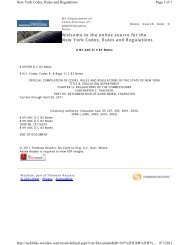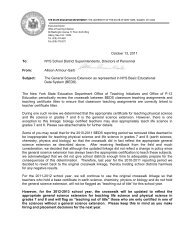ESL Learning Standards - Higher Ed - New York State Education ...
ESL Learning Standards - Higher Ed - New York State Education ...
ESL Learning Standards - Higher Ed - New York State Education ...
Create successful ePaper yourself
Turn your PDF publications into a flip-book with our unique Google optimized e-Paper software.
Standard 1:<br />
Students will listen, speak, read, and write in English for<br />
information and understanding.<br />
Intermediate Grade Sample Classroom Tasks:<br />
English Proficiency Level<br />
Beginning<br />
Teacher shows brief timeline of her life. Students use a<br />
graphic organizer (e.g., wheel) to brainstorm important<br />
events in their lives (e.g., moving, starting school). They<br />
choose at least five events from their own lives, place these<br />
events on a timeline, and select one event and write a<br />
short description of it. Timelines and descriptions are posted<br />
in classroom.<br />
Performance indicators: 3, 12, 13<br />
Intermediate<br />
Students use Beginning brainstorming and timeline task.<br />
They interview family members to expand the timeline with<br />
events such as their first word or first steps. Students present<br />
timelines to class. Peers comment on most<br />
surprising/interesting events. Each student selects one significant<br />
event and writes a brief description of it and an<br />
explanation of why it was memorable.<br />
Performance indicators: 3, 5, 8, 9, 12, 13, 14<br />
<strong>ESL</strong><br />
1<br />
Interm<br />
Students peruse Zoo Books and choose an animal. Class<br />
brainstorms a vocabulary list of the parts of an animal.<br />
Students in small groups make a large drawing of their animal<br />
and label it. Teacher posts labeled pictures in the classroom.<br />
Performance indicators: 2, 7<br />
Teacher shares picture book on an upcoming social studies<br />
topic such as the Iroquois or the Age of Exploration, and<br />
then talks about pictures, using key vocabulary from social<br />
studies text to be used. Teacher then adapts a section of a<br />
social studies textbook, identifies key vocabulary, and illustrates<br />
vocabulary words where necessary to use as a study<br />
guide. Students highlight vocabulary words in text, and<br />
teacher/students read and discuss text. Students demonstrate<br />
text comprehension through participating in a trivia<br />
game or crossword puzzle.<br />
Performance Indicators: 1, 2<br />
Students peruse Zoo Books, choose an animal, and list 5-10<br />
facts extracted from pictures and text. Then they draw and<br />
label their animal and use facts to write two questions and<br />
answers about the animal. Students exchange pictures<br />
and questions, and writer supplies correct answers when<br />
necessary.<br />
Performance indicators: 1, 2, 4, 5, 7, 9<br />
Students may complete Beginning task before brainstorming<br />
types of transportation used by explorers, as gleaned<br />
from their social studies textbooks, and scan their textbooks<br />
for these and other types. They discuss boats, distance,<br />
and time. Then they chart boat passage from<br />
Europe to <strong>New</strong> World (distance/miles per day), tracking<br />
daily.<br />
Performance indicators: 1, 2, 3, 9<br />
Class generates a list of basic personal questions (e.g.,<br />
name, age, address, favorites) for paired interviews with a<br />
classmate. Each student prepares answers, partners interview<br />
one another, and each writes brief bio of partner and<br />
introduces partner to the class. Teacher publishes class<br />
book for distribution to all classmates with photos taken in<br />
class or during home visits.<br />
Performance indicators: 3, 5, 7<br />
Class discusses issues of career choice and preparation for<br />
different careers. Together, class generates a list of basic<br />
personal questions for interviewing an adult from the student’s<br />
home country about his/her career choice (what<br />
education, experiences, or other preparation the person<br />
had for his/her career, what the person’s goals were, etc.).<br />
After conducting the interview, students may share information<br />
with class. Students complete self-reflection forms,<br />
noting what was surprising, interesting, and informative<br />
about the interviewee or career.<br />
Performance indicators: 2, 3, 4, 5, 7, 10, 12, 15<br />
68 <strong>Learning</strong> <strong>Standards</strong> for <strong>ESL</strong>
















